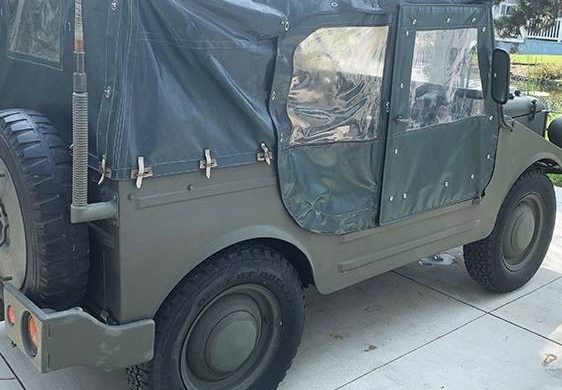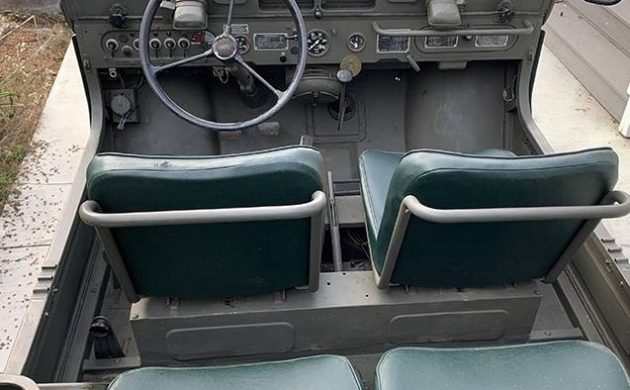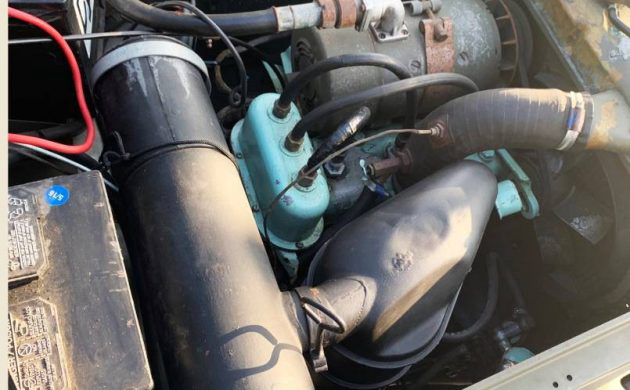German Jeep: 1963 DKW Munga
This 1963 DKW Auto Union Munga Jeep is a rare sight anywhere, but particularly in the United States. Built with a similar philosophy to the WWII-era Jeep and Ford GPW, it’s an extremely capable vehicle for when the going gets rough, but it’s an acquired taste for driving around city streets or anywhere the road opens up. The seller reports that this German oddball has been routinely serviced by a local specialist shop and comes with all of its rare original military gear and a full soft top. Find it here on craigslist in San Diego for $12,900, and thanks to Barn Finds reader Rex M. for the find.
San Diego is probably the perfect city to use a vehicle like this in. As some of you recall, I owned a 1981 Toyota HiAce for a while, and my ultimate goal was to keep it long enough that I I could someday retire somewhere that short drives into town and low-speed cruising was the norm – living on an island, in other words. It just seemed like the perfect setting for a diesel-powered van with four speeds and a column shift. This DKW strikes me as needing a similar environment to be remotely pleasurable to use, and certainly a community with some of the best weather in the country to enable top-down driving makes loads of sense. The side curtains are likely hard to come by and very nice to have.
The interior is a simple affair but in excellent condition. Seating arrangements came in a few different options, including accommodating up to six or eight passengers. Like any wartime conveyance, this were not one trick ponies: in addition to carrying troops, they were used as ambulances, farming vehicles, and weapons carriers. The seller includes photos that show this Munga comes with all sorts of cool period accessories, or at least as much extra equipment a military vehicle could be equipped with – including an original tool kit, jack, radio, five gallon jerry can, original owners manual and other literature.
The 900 cc three cylinder, two stroke engine shows just 75,000 kilometers, and amazingly, the listing claims the DKW “…. climbs 60 degree slopes and drives in water over 30 inches.” This doesn’t appear to be hyperbole, as multiple enthusiast sites make the same claim. Owning one of these requires a few different prerequisites, in my opinion: a large collection of vintage military vehicles; a farm; an island community with roads that don’t exceed 30 miler per hour. This DKW is a rare find, but with no real guidance in terms of pricing, it’s hard to say whether the asking price is fair. What do you think?
Auctions Ending Soon
 1977 Datsun 280ZBid Now22 hours$600
1977 Datsun 280ZBid Now22 hours$600
 1969 Ford MustangBid Now2 days$500
1969 Ford MustangBid Now2 days$500
 1965 Ford Falcon Station WagonBid Now5 days$1,000
1965 Ford Falcon Station WagonBid Now5 days$1,000
 2002 Jaguar XK8 ConvertibleBid Now6 days$100
2002 Jaguar XK8 ConvertibleBid Now6 days$100





Comments
Seems like the right concept to have a 2 stroke in one of these. Simplicity and no oil to get thick in the winter or oil pressure loss on the 60 degree slope. Of course most of what DKW had back in the day was 2 stroke until they dabbled in all things Wankel. To bad it was a flop for them. Neat historic military vehicle. Reminds me a lot of the VW counterpart.
Good points – no oil to get thick during winter is one of the not so many true benefits unique to 2strokes and also one of the reasons SAAB opted for 2poppers to begin with
Good luck finding another one, but $12900?
Looks like a load of fun, provided you can keep your patience with all the people asking about where you got the Audi jeep!?
Kinda neat… you can definitely see some genetic traits of the younger VW Thing in this German family member…💪
The Saab 2-strokes were designed by a former DKW engineer. DKW was the world´s largest motorcycle manufacturer up until about 1959 as well as being the gold standard for 2-stroke engine development. Their bikes formed the basis for the russian motorcyle industries (NOT BMW which was the basis for the Ural only) The 1955 DKW RT- 350 ranks as one of the most beautiful bikes of all time, their cars were legendary and their Monza Sports Cpe established several world speed records. The 900 (later 955 cc´s) engine dated back to 1940 and was also used by East Germany´s Wartburg. DKW eventually turned into Audi, even though originally it was Audi which joined them in the Auto Union way back in 1929 or so.
Wow! A MUNGA [Not to be confused with “Cow-a-bunga!”].
In the 1980s I found a 1958 DKW Munga that had been sold new to a hunter in central Pennsylvania, so he could go deep into the woods, where he claimed American trucks feared to go. My Munga was a civilian version painted light grey and it had a DKW emblem up front, not the 4 circles representing Auto Union.
There were 2 drawbacks to using this vehicle, the first was simply getting it started. From a cold start we always had to pull it with another vehicle to about 15mph before it would start & run on it’s own. Even in a warm start I was always worried it would run out of battery power before it started.
The other problem was stability. These things were incredibly top heavy due to the high ground clearance and thin tires. Anything above 30mph was risking a roll-over accident. One time I almost flipped it [for a second or 2 it was balancing on the left 2 wheels only] when I tried to avoid something in the road.
But taking it into sandy and marshy conditions here around the Chesapeake Bay, it was damn near impossible to get stuck. Put in low range, low gear, it would just slowly keep lurching forward, slow enough to get out and walk beside it!
At that time there was a guy out in Washington state who specialized in DKW and Munga parts, I was able to get anything I needed for it, including a new plastic engine fan and exhaust manifold. Sold the Munga to a well-known rare vehicle collector in Ohio, I think he’s still got it.
They are great fun to run around on a farm or a large estate, but not cruising down the highway!
Do you remember the place in Washington that has the parts?
Larry, I don’t know if this is still good information, as it’s 40 years old, but here it is:
Columbia Equipment Co, Attention: Norm.
412 N E Columbia Blvd
Portland, OR 97211
503-288-6981
Please let me know what happens, [email protected]
I was stationed in Germany back when these were still in use by the West German military, and those army guys once told me that when practicing maneuvers during their cold winters, they always kept at least one Munga idling all night long, as it would be needed in the morning to pull-start another Munga, then those 2 would pull 2 more to start, and so forth, until all were running!
They also said that because they used so many 2-stroke vehicles, and the East German army used even more 2-stroke vehicles, that the chance of either side engaging in a surprise attack was almost impossible, as the side being attack would have ample notice from the huge cloud of blue smoke headed their way!
In German DKW = Die kleine wunder (the little wonder) or Deuche kinder wagen (German kiddie car)
Andy,
While the DKW emblem translation is traditionally known today as “The Little Wonder”, The 3 initials go further back than when the company began building automobiles about 1916. And yes, the DKW automobile company was using that version in their advertising as early as the 1930s.
Prior to that era, DKW was manufacturing steam valves and fittings. Based on early company records & letterhead, the DKW stood for Dampf-Kraft-Wagen, in English it translates to Steam Powered Wagon.
Here’s what a website on 2-stroke vehicles says about the early days of DKW:
The Dane Jorge Skafte Rasmussen (1878-1964) studied engineering at Chemnitz and in 1904 together with his friend Ernst set up Rasmussen & Ernst GmbH, a company to trade in exhaust steam oil traps and pipe fittings.
During the 1914-18 War Rasmussen experimented with a steam powered car: Dampf-Kraft-Wagen (DKW), a project that was abandoned at the end of the War because of cost reasons.
In 1916 Rasmussen founded a factory in Zschopau, Saxony, Germany to produce steam fittings and in the same year DKW was formed.
I see a “Thing”.
I see the beginning of an Audi. At least the circles point in that motif direction.
Phil,
The 4 circles represent the automobile organization known today as Auto-Union. The circles represent the original 4 automobile companies who combined to create the organization. They are [In no specific order];
Audi, Horch, Wanderer, and DKW.
After WW2, Horch & Wanderer never manufactured vehicles again. DKW continued making 2-sroke cars, changing their name to the Auto-Union name & logo about 1958. All their 1,000cc 2-stroke cars were sold under the Auto-Union banner until 1969, when they closed the plant in Germany, but continued manufacturing cars in Brazil until 1967. With the other 3 makes defunct at that point in time, Audi began using the 4 ring logo as their own.
Bill,
Well thanks for that trivial info. As I’ve said before, I have learned much (learnt if you are a nerd,) from this site.
I’m ALWAYS open to new data or Intell.
You sure nailed it!
I do know the car personally as I have seen it at Cars and Coffee here. Seriously, absolutely awesome for what it is but the great condition it is in is unreal! Anyone who can snap this one up for the low $12,900 he is asking will get a deal!
Klaus,
I agree, this is a very fair price. While the number of people seeking a Munga here in North America is rather small, anyone who wants one would be advised to take a serious look at this example. I doubt finding a rust-free example will be possible in Europe, as I remember these having rust issues when I was in central Germany 40 years ago.
Similar condition Munga vehicles, but later 1970s versions, typically are more expensive in Europe, plus shipping. Rusty examples needing major repairs start at about $5k, again, plus shipping
Military vehicle collectors should be looking at this one. Similar vehicles like the Swiss Pinzgauer 710 [the smaller version] START at $25k for decent versions, and go up from there. The 6 wheel versions can go for double that price.
The 4 rings represent 4 different manufacturers who joined together in 1929 during the Great Depression to avoid going under. 1) DKW 2-stroke specialist manufacturer of motorcycles including 1 liter watercooled side car machines. 2) Wanderer middle class automobiles, bicycles and a marvelous 750 cc twin cylinder 4 stroke bike. This machine was top-end and was discontinues after the merger due to costs. 3) Audi, manufacturer of middle class sedans, front-wheel drive pioneers 4) Horch, heavy luxury cars direct competitors to Mercedes. In the 30´s it was the Horch Factory which manufactured the famed Auto Union Formula 750kg race cars. Horch passenger cars were heavily used on the eastern front including modified ones as trucks. Almost none survived the war.
Was it common for munga engines to seep water from the head every now and then? Nothing serious and nothing entering the engine?
Larry,
As far as I know, the Munga engine was basically the same as the DKW cars, and they were not known to have head gasket problems any more than other European cars of that time frame. You might want to check the torque specs for the head bolts.
Thank you for your reply. We have been having this issue with our 1000 cc in the munga. We’ve torqued to specs (45), added permatex to gasket and still get seepage around the edge f th om water jacket. Nothing leaks inside, just around the edge. Were a bit baffled.
Larry,
I’m assuming you’ve replaced the headgasket with a new one already.
These are fairly low compression engines, but can have overheating issues due to poor coolant circulation, [they don’t have a water pump & rely on thermo-syphon for circulation] especially in the warmer regions of north America. As someone who has been rebuilding engines for decades, I suspect you’ve either got a curved [warped] cylinder head surface, and possibly a block that needs resurfacing [or both]. I would also check to make sure the coolant is circulating freely thru the radiator.
The gaskets didn’t show any indication of leaking. We have decided to have both surfaces of the head checked and machined if needed. They look true, but we are going to make sure. We have looked into to cooling and it appto be flowing without restrictions. Very much appreciate your advice. Very helpful!!!
R/
Larry